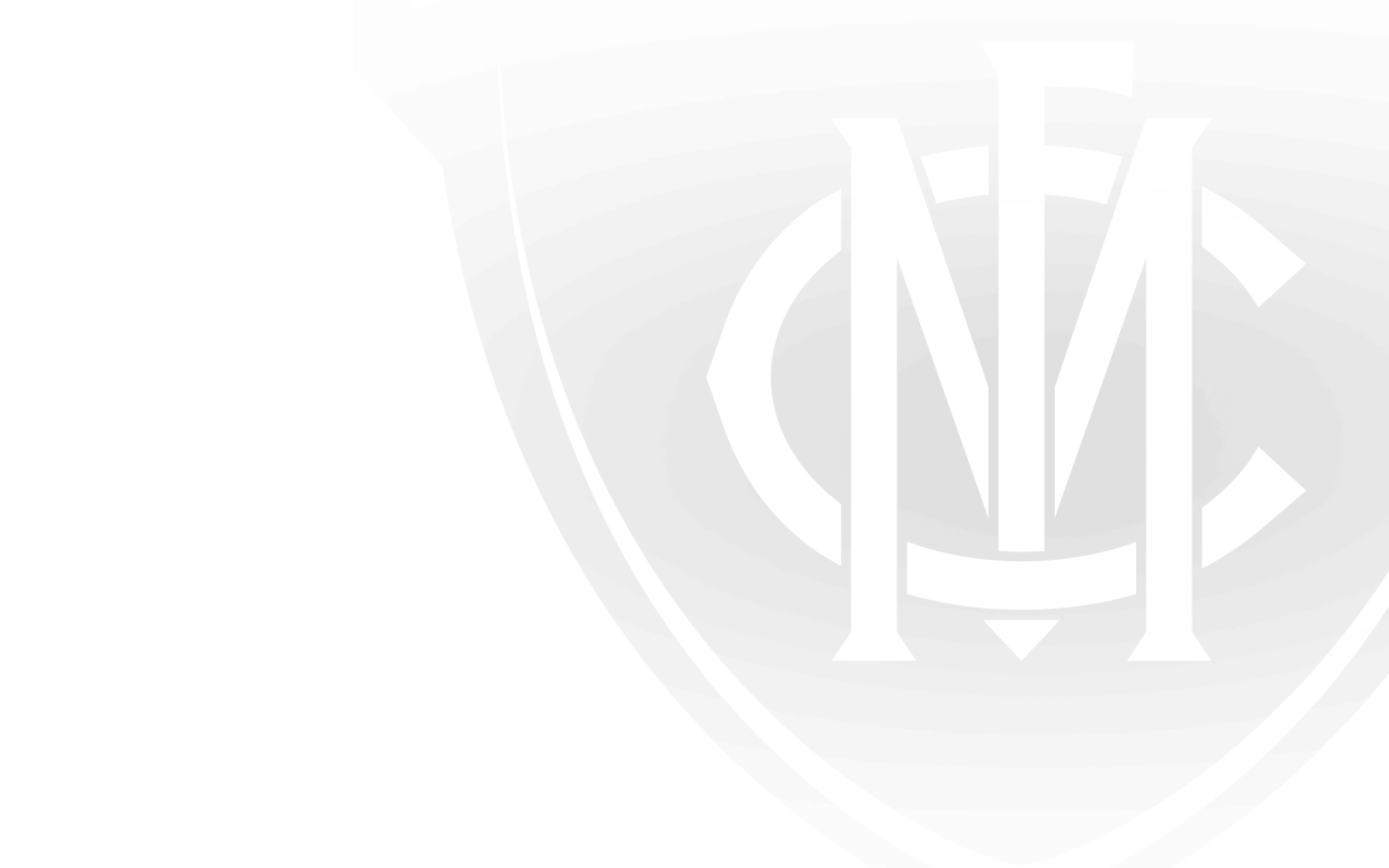Read on for a comprehensive summary of every year of Melbourne's existence, compiled by Matt Burgan.
The 1850s
1858
On July 10, a letter written by Thomas Wentworth Wills (Tom Wills) was published in Bell’s Life in Victoria and Sporting Chronicle. He proposes a “foot-ball club” to keep Victorian cricketers fit in winter. Publican Jerry Bryant provides a ball for a scratch match on July 31. A match between players representing Melbourne and South Yarra (26/30 players per side) took place in Yarra Park (then known as Richmond Paddock) on September 25.
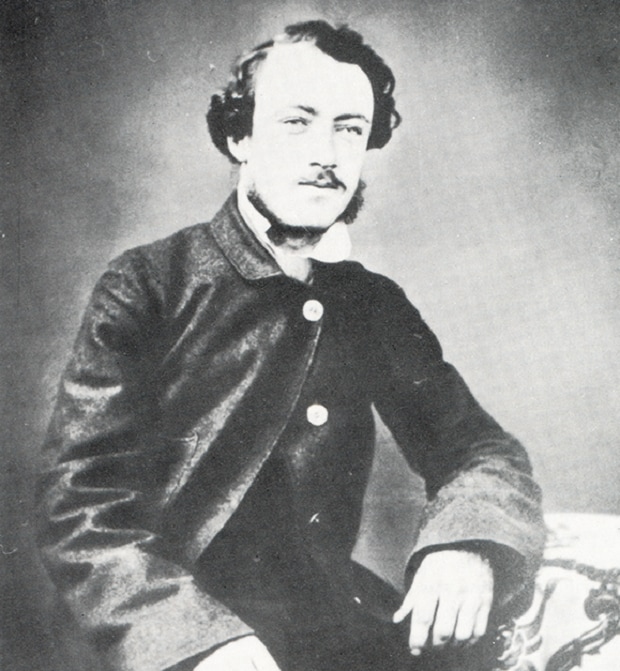
Tom Wills, the club's co-founder, in conjunction with local sportsmen and identities William Hammersley, Thomas Smith and James Thompson
1859
Following a scratch match on Saturday May 14th between two sides chosen by Jerry Bryant and Thomas Smith, a preliminary meeting of gentlemen interested in the game was subsequently held at the Parade Hotel in East Melbourne, with the object of forming a "Football Club." At the meeting, a secretary, treasurer, and committee of five were appointed to conduct the affairs of the club. J.B. Thompson was appointed secretary. The Melbourne Football Club is founded.
On May 17, Committee members Tom Wills, William Hammersley, James Thompson and Thomas Smith meet at Bryant’s Parade Hotel and draft the first ‘Rules of the Melbourne Football Club May, 1859’. The rules form the evolution of Australian rules football. Henry (HCA, also known as ‘Colden’) Harrison, an early great and Tom Wills’ cousin, plays for Melbourne. Hammersley (v South Yarra) and Wills (v St Kilda) were named as the Melbourne Captains.
The 1860s
1860
The first annual general meeting of Melbourne is held on April 27.
Five of the ten matches that Melbourne played in 1860 were against Richmond. Wills and Harrison played with Richmond when Melbourne played Richmond.
1861
A move to merge Melbourne and Richmond (a different side to the one we know today) is put forward at a meeting on April 27. It’s rejected, but players from both clubs remain interchangeable – which is not unusual in the early years. Melbourne adopts a Magenta uniform, which is no longer used within three years. Melbourne plays University in the ‘Challenge Cup’, a football trophy contested in Melbourne during the 1860-70s.
Wills (Queensland) and Thompson (Bendigo) left Melbourne at the beginning of 1861, both would return to Melbourne in 1864
1862
Melbourne has a tough season, including the inability ‘to make up a team’ to head to a match in Geelong. Harrison plays with Geelong for the 1862 football season. T H Smith is the secretary of the Club in his final year at Melbourne
1863
Henry Harrison returns to the club as captain. Participation at Melbourne is at its lowest point
1864
After two tough seasons, the game starts to improve. On May 21, a match captained by Harrison and Richard Wardill is played. Wardill’s team wears red and Harrison’s wears blue. Melbourne is known as the ‘Invincible Whites’. Harrison is elected to the MFC Committee which was the beginning of a long involvement as an administrator of the Club.
1865
A ‘Challenge Cup’ is set up featuring Melbourne, Carlton, Geelong, Royal Park, South Yarra and University, after intermittent matches are played in previous years. Tom Wills was a member of the Committee in his final year with the MFC.
1866
On May 5, Harrison and Richard Wardill represent Melbourne as the major clubs gather to review the rules of the game.
1867
The Challenge Cup is put on hold. On August 3, Melbourne wins its only match for the season against HM 14th Regiment.
1868
Melbourne is boosted by recruits from Carlton: James Byrne (in 1866), Charles Forrester (1867) and Harry Chadwick (1868).
1869
Representatives from Melbourne, Carlton, Albert Park (formerly Emerald Hill), South Yarra and Hobson’s Bay Railway draw up the official fixture, which is published in newspapers. Melbourne wins seven matches, draws six and loses one, and has 23 members.
The 1870s
1870
Melbourne plays 12 matches for seven wins and five draws, and is widely regarded as premiers.
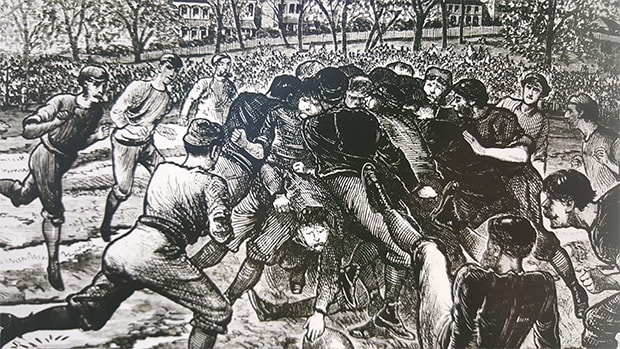
A sketch of a game between Melbourne and Carlton 1870 which appeared in The Australasian Sketcher
1871
Melbourne loses to Carlton in the South Yarra Challenge Cup – the first premiership play-off. After the match, Harrison becomes ill and retires. He later becomes a key administrator in the game.
1872
Melbourne becomes known as the Redlegs, after former player and supporter Larry Bell donates a set of red stockings from his trip to England. Given Melbourne is already wearing blue caps, the two colours come together to form what we know today. Bell also donates blue stockings to Carlton, hence becoming the Blues. Melbourne is premiers from Carlton and Albert Park.
1873
The club decides the uniform should consist of a red cap, blue shirt and knickerbockers and grey stockings. Instead, red stockings are used for matches. Melbourne wins two more matches than Carlton, but the Blues are declared premiers.
1874
A rule, initially trialled in 1871, is formally adopted that says players can only play for one club a year. This impacts Melbourne the most.
1875
Despite setting a club record for the most goals in a season, with 43, Melbourne finishes second, with Carlton winning the Challenge Cup.
1876
Melbourne wins the Challenge Cup over Carlton.
1877
The Victorian Football Association (VFA) is formed at Oliver’s Café in Melbourne on May 7. Melbourne, Carlton, Essendon, Geelong, Albert Park, Hotham, St Kilda and East Melbourne are the inaugural teams. Melbourne finishes runner-up to premier Carlton in the first season.
1878
Melbourne finishes runner-up to Geelong, after being beaten in an extra playoff game.
1879
Melbourne returns permanently to the Melbourne Cricket Ground, playing its first game on the MCG since 1872.
The 1880s
1880
Melbourne finishes fourth behind Geelong, Carlton and South Melbourne.
1881
A club office is opened, as Harrison moves a motion that sees the first 20 elect the captain and vice-captain. Unofficially Melbourne finishes fourth.
1882
Melbourne has a poor season – one of its worst years – notching up its first win of the season against eventual premier Geelong in July. A selection committee is appointed following the annual general meeting.
1883
A much-improved year, as Melbourne wins 12 matches. Henry Harrison is named the first life member of the club.
1884
Harrison is named the first Life Member of the Melbourne Football Club.
1885
The Melbourne Cricket Club orders Melbourne off the MCG, after it prefers Carlton as its tenant. Melbourne then loses the Football Ground in Yarra Park, before it moves to Friendly Societies’ Ground (the Olympic Park Precinct). It then eventually returns to the MCG. It’s a tough year for the club, as it wins seven games and second last in ninth position.
1886
After several difficult seasons, Melbourne wins seven games in a row late in the year.
1887
Melbourne finishes 10th with seven wins, 13 losses and three draws.
1888
Melbourne moves to the Friendly Societies’ Ground for the second time. The club wins four matches and finishes 14th.
1889
At the club’s annual general meeting, Melbourne considers a merger with University. Although the meeting agrees to a merger, it states that no change can be made to the club’s name or colours. Melbourne settles for claiming eight University players. The club has a poor season, winning four games and finishing second last, with its best player Alex McKenzie leaving the club for Carlton. Melbourne uses 74 players for the year – the most of any senior team in the 19th century. At the end of the year, the MCC takes control of the football club, as Melbourne is in financial crisis. The Cricket Club agrees to take over its limited assets and incorporate the Melbourne Football Club. It is an important step, given Melbourne’s future is under serious threat.
The 1890s
1890
The MCC pays off the debts of Melbourne, which it incurs throughout the 1880s. It finishes eighth with six wins.
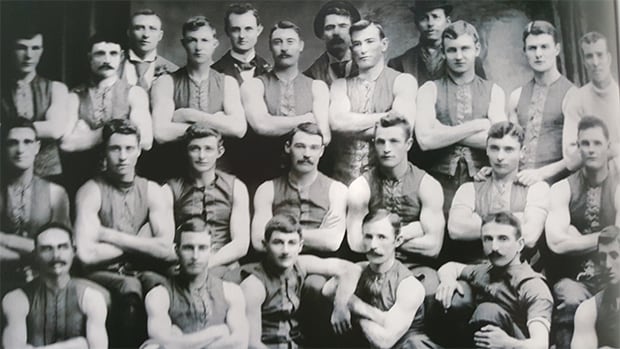
The team of 1890 pictured prior to a club trip to Hobart
1891
Melbourne’s second 20 are disbanded to help save money. It finishes sixth with eight wins.
1892
The club finishes fourth and improves with 10 wins. One of the reasons given for Melbourne’s improvement is due to a new type of leather boot the players wear over their ankle.
1893
Melbourne finishes runner-up to Essendon. The club wins 16 matches for the season.
1894
Melbourne again finishes runner-up to Essendon.
1895
Melbourne finishes third, after starting the year with eight consecutive wins.
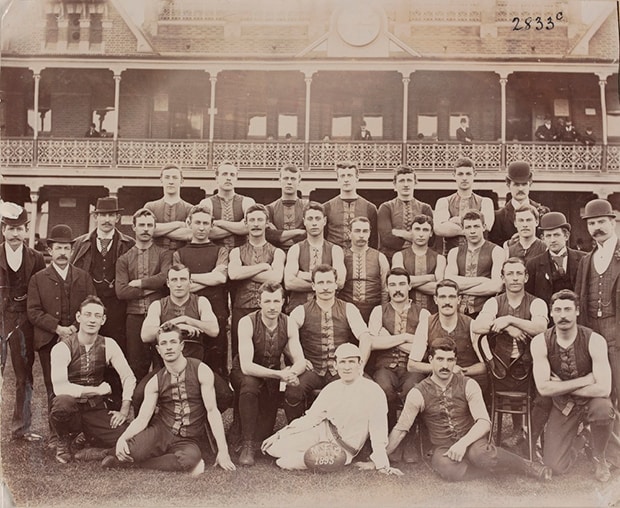
The Melbourne team in 1895
1896
Melbourne’s final season in the VFA sees it finish fourth. On October 2, a breakaway competition known as the Victorian Football League is formed. Melbourne signs on with Carlton, Collingwood, Essendon, Fitzroy, Geelong, St Kilda and South Melbourne.
1897
The first VFL season is under way. Melbourne plays South Melbourne in its inaugural match, and wins by 17 points at Lake Oval. Melbourne comes third at the end of the home and away season with 10 wins, before finishing fourth following round robin series. Ned Sutton is Melbourne’s first captain, while Fred McGinis is widely regarded as the game’s best player in the first VFL season. Jack Leith is the VFL’s equal leading goakicker with Geelong’s Eddy James at the end of the home and away season. They kick 22 goals each, before James ends with 27 at the end of the finals and Leith claims 26. Henry Harrison is Melbourne’s first VFL chairman and Hugh McLeod is secretary for club’s inaugural VFL season, after holding the position since 1890.
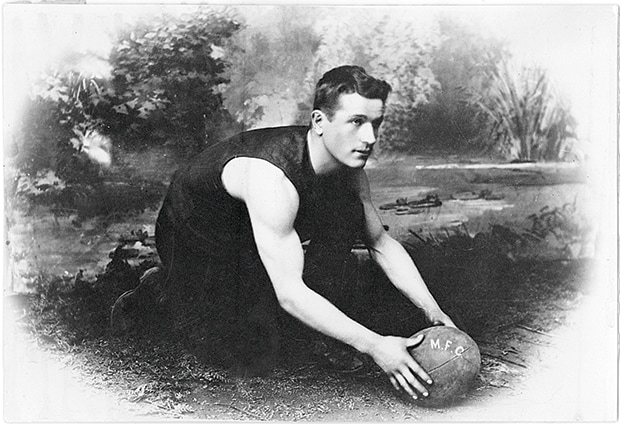
Fred McGinis gets ready to take an old-fashioned place kick
1898
Melbourne’s second season sees the club win five matches and finish sixth. Charlie Young tops the club’s goalkicking with 21 goals. Amos Norcott becomes secretary.
1899
Again, Melbourne claims sixth position, with eight victories. Eddie Sholl becomes captain and Jack Leith leads the club’s goalkicking for the second time with 21 goals. GW Lamb takes over as secretary.
The 1900s
1900
Melbourne wins its first VFL premiership – its first championship at any level since 1876. After finishing sixth with six wins, and defeating Essendon in the preliminary final at Lake Oval, Melbourne claims the flag over the favoured Fitzroy by four points at East Melbourne. Dick Wardill is Melbourne’s premiership captain, Tommy Ryan boots 24 goals to lead the club’s goalkicking and Amos Norcott becomes secretary for the second time. Fred McGinis and Vic Cumberland are among Melbourne’s best. Cumberland, later playing with St Kilda in 1920, becomes the oldest player to play a VFL/AFL match, when he plays as a 43-year-old. It’s a record that still stands today.

The 1900 Premiership team
1901
Melbourne misses the final four on percentage. After leading Fitzroy by five points at three quarter-time, Melbourne falls 13 points short at Brunswick St Oval to finish fifth with nine wins and one draw. W.C. (Bill) McClelland becomes captain. He later becomes of the game’s most important figures, with the W.C. McClelland Trophy named in his honour. Frank Langley kicks 17 goals to top the club’s goalkicking and the great Fred McGinis retires.
1902
After making the final four with nine wins, Melbourne loses its semi-final clash to Essendon at Princes Park. For the third time, Jack Leith is Melbourne’s highest goalkicker in a season with 26 majors.
1903
Melbourne has a poor season, winning three matches to finishing seventh. Charlie Young becomes the first player to reach 100 VFL games for Melbourne. He achieves this against Collingwood in round five at Victoria Park. Vin Coutie boots 19 goals to lead Melbourne’s goal tally.
1904
Although Melbourne misses out on the finals again, it wins eight games to finish sixth. Melbourne plays its first VFL interstate match against Essendon at the Sydney Cricket Ground. Melbourne wins by 32 points. Vin Coutie wins the VFL goalkicking with 39 goals and Bill McClelland retires at the end of the season.
1905
Melbourne claims its first wooden spoon, after just three wins. Frank Langley becomes skipper and Harry Cordner manages 16 goals to lead Melbourne’s goalkicking.
1906
One of Melbourne’s poorest seasons in VFL/AFL history. It claims just one victory for the season and its second wooden spoon in succession. Arthur Sowden takes over as captain and Basil Onyons boots 16 majors to top the club’s goal scoring.
1907
Alex Hall becomes Melbourne’s first coach. Although Melbourne improves with seven wins, it finishes second last. TF Morkham takes over as chairman, while George Beachcroft becomes secretary. Vin Coutie becomes captain and Jack Leith leads Melbourne’s goalkicking for the fourth time with 21.
1908
Melbourne celebrates 50 years. The club’s golden jubilee coincides with the first interstate carnival – known as the Jubilee Australasian Football Carnival – including a team from New Zealand. Melbourne wins another seven matches, finishing eighth. Hugh Purse becomes skipper, Vin Coutie tops Melbourne’s goals for the third time with 37 majors, while Amos Norcott becomes secretary for the third time.
1909
Melbourne just misses the top four, finishing with 10 wins, seven losses and one draw. Bernie Nolan captains the club, as Harry Brereton leads Melbourne’s goal scoring with 34 and JA Harper becomes secretary.
The 1910s
1910
A tough season for the VFL, with several incidents on and off the field marring the year. In round 16, the VFL investigates rumours that South Melbourne players offer Melbourne players money to ‘play dead’. South Melbourne is found innocent. Melbourne instigates the VFL to give all umpires, including goal and boundary, the power to report players for violent conduct. Melbourne finishes second last with four wins. Eddie Drohan coaches Melbourne in his only season, while Vin Coutie becomes captain and Stan Fairbairn claims 24 majors to lead Melbourne’s goal tally. JA Harper resigns as secretary in May, before GW Lamb replaces him. TF Morkham finishes as chairman.
1911
Alex Hall returns as coach, while Harry Brereton tops the VFL goalkicking at the end of the home and away season with 46 goals. Carlton’s Vin Gardiner, who kicks 43 at the end of the home and away season, boots 46 goals at the year’s end. Melbourne claims seven wins, a draw and 10 losses to land seventh on the ladder. Arch Aitken is president for one year.
1912
Alf George is named skipper ahead of the 1912 season. Harry Brereton leads the VFL goal tally again with 56 goals, as the VFL introduces numbers on the back of jumpers. The Football Record is also published for the first time. Melbourne finishes sixth with nine wins. W.C. McClelland becomes Melbourne chairman and Andrew Manzie becomes secretary.
1913
Melbourne slips to second last, after gaining four wins. Mick Maguire tops the club’s goalkicking with 13 majors for the year – the lowest goalkicking tally in a season by a Melbourne player.
1914
Len Incigneri becomes captain-coach and Artie Best boots 30 goals to lead the club’s goalkicking. Melbourne wins two games and finishes second last to University, which claims its fourth wooden spoon in a row, in its final VFL season.
1915
With the collapse of University, a host of Students join Melbourne for the season. Former Essendon player Jack McKenzie takes over as captain-coach. With World War I imminent – the ANZACs land at Gallipoli a day after round one – a motion is put forward by Geelong to cancel the season. Melbourne seconds it, with Essendon, St Kilda and South Melbourne joining in. But the motion fails to be carried by two third and the season goes ahead. Melbourne returns to the finals for the first time since 1902, but loses to Carlton by 11 points at the MCG in the semi-final. Roy Park manages 35 majors to lead Melbourne’s goalkicking.
1916
Melbourne votes to go into recess until the end of the war. Only four clubs compete in the VFL: Carlton, Collingwood, Richmond and Fitzroy.
1917
Geelong and South Melbourne return to the VFL, as Melbourne misses its second consecutive season due to World War I.
1918
Eight clubs compete in the VFL, after Essendon and St Kilda return. It’s Melbourne last season out of the VFL/AFL, before rejoining for 1919.
1919
After being out of the VFL for three seasons, Melbourne returns to the league. Unfortunately, Melbourne suffers statistically its worst VFL/AFL season, when it fails to win a game. George Haines (Heinz) takes over a captain-and leads the club goalkicking with 15 goals. Future dual Brownlow Medal winner Ivor Warne-Smith makes his debut.
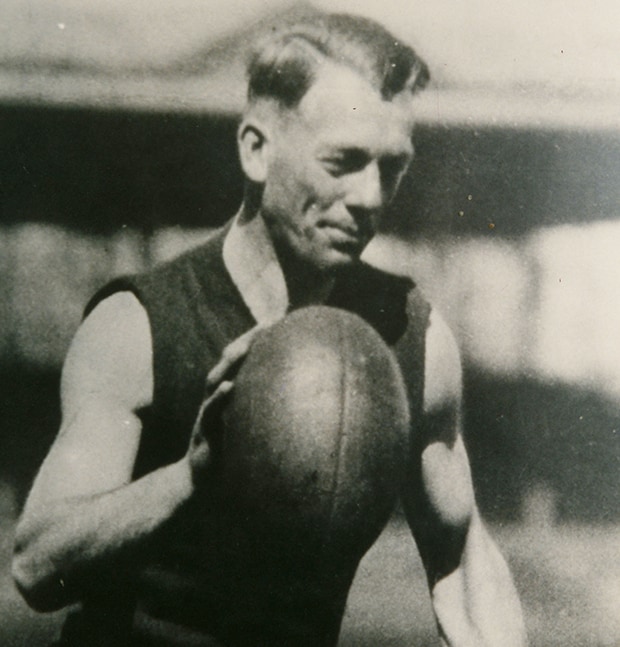
Ivor Warne-Smith pictured later in his career
The 1920s
1920
George Haines (Heinz) remains captain, but former Fitzroy captain Gerald Brosnan takes over as coach. Bert Chadwick makes his debut for Melbourne and Harry Harker lands 23 goals for the year to lead the club goalkicking. The club notches up two wins for the season and finishes second last.
1921
Two-time Collingwood premiership player and former skipper Percy Wilson takes over as captain-coach. He guides the club to sixth: six wins, two draws and eight losses. In round 18 against Geelong at the MCG, Harry Harker becomes the first player to kick 10 goals in a match for Melbourne. He leads the club’s goalkicking with 47.
1922
Melbourne finishes sixth again, but with seven victories – its best result since 1915. Harry Harker backs up his 1921 season with another 47 goals to top Melbourne’s goalkicking for the third year in succession.
1923
Melbourne claims its fourth wooden spoon, after winning just three games. Percy Tulloh boots 31 goals to lead the club’s goalkicking.
1924
Gordon Rattray takes over from Percy Wilson as coach. He makes his coaching debut at age 25 years, 189 days – the second youngest in VFL/AFL history behind Geelong’s Bert Taylor (22 years, 343 days). The first Brownlow Medal is held. Geelong’s Edward ‘Carji’ Greeves receives the first medal, with new captain Bert Chadwick finishing second – just one vote behind the inaugural winner. Percy Tulloh tops the club’s goals for the second year running with 24. Melbourne defeats eventual premier Essendon in the final round to avoid the wooden spoon. It finishes eighth, with St Kilda coming last.
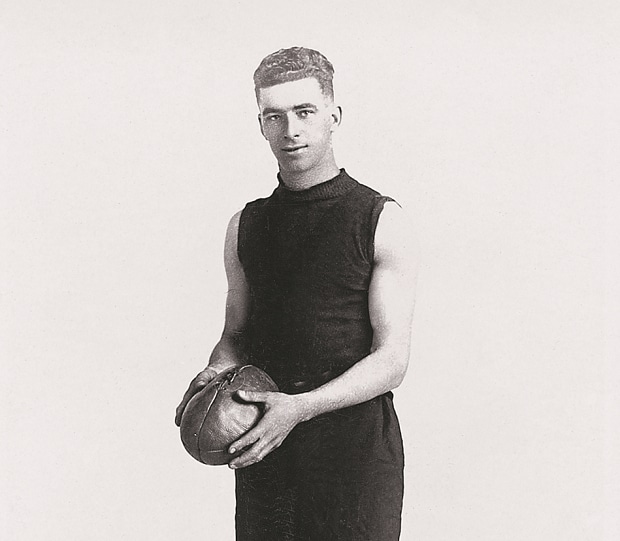
Bert Chadwick was runner-up in the first ever Brownlow Medal in 1924
1925
Bert Chadwick takes over as captain-coach. He guides Melbourne to the finals, where it wins its first final since 1900. Melbourne defeats Geelong in the semi-final at the MCG, before falling to Collingwood in the preliminary final at the ‘G. The club finishes third with 12 wins, one draw and four losses. Harry Davie, who leads Melbourne’s goalkicking with 56 for the year, boots 13 goals against Carlton in round 14 at Princes Park.
1926
Melbourne wins its second VFL premiership, defeating Collingwood by 57 points at the MCG – ending a 26-year drought. Henry Harrison, then 89 years old, was among those at the victory. Bob Johnson kicks six goals in the win, while Jim Abernethy is regarded as one of the club’s best in the win. Melbourne defeats Collingwood in the semi-final at the MCG, before overcoming Essendon in the preliminary final at the ‘G. Ivor Warne-Smith becomes the club’s first Brownlow Medal winner. Melbourne records its greatest winning margin in VFL/AFL history – a record that stands today – when it defeats Hawthorn by 141 points in round nine at the MCG. Harold Moyes lands 55 goals for the season – the most for Melbourne. Bill McClelland steps down as chairman and becomes president of the VFL – a position he holds until 1956.
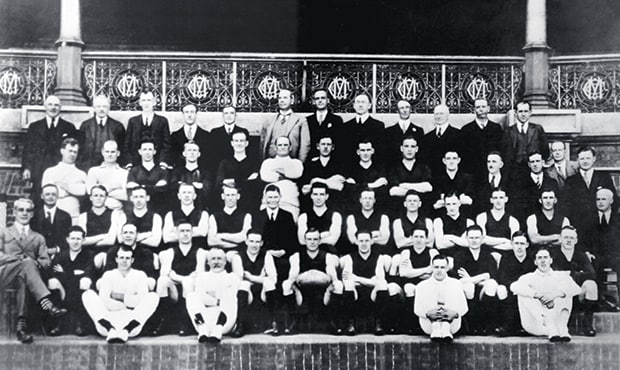
The 1926 Premiership side
1927
After being on top of the ladder midway through the season, Melbourne misses the finals and finishes fifth with 12 wins. Harry Davie boots 40 goals to lead the club’s goalkicking for a second time. Former Australian cricketer Vernon Ransford takes over as president.
1928
Melbourne returns to the finals, drawing with Collingwood in the semi-final. After the two sides play in the first drawn VFL final, Melbourne falls four points short. Both matches are played at the MCG. Melbourne finishes third as Collingwood wins the second of four flags in a row – the only team in league history to achieve this feat. Ivor Warne-Smith, who takes over as captain-coach, creates VFL/AFL history by becoming the first player to win two Brownlow Medals. Bob C. Johnson boots 55 goals to lead the club’s goalkicking. Norman Drives wins Melbourne’s first Gardiner Medal – the reserves equivalent to the Brownlow Medal. Vernon Ransford retires as chairman.
1929
Melbourne misses the finals, finishing fifth with 11 wins, one draw and six losses. Joe Blair is appointed chairman and club great Henry Harrison passes away aged 93 years old on September 2. Dick Taylor leads the goalkicking with 29 majors for the season.
The 1930s
1930
The league moves into its new Spring St headquarters and names it Harrison House, after the late Henry Harrison. George Margitch kicks 11 goals in round nine against Essendon at the MCG, and leads the club goalkicking with 73. Melbourne is on track for finals, until losing its final three home and away rounds to finish fifth with 11 wins.
1931
Melbourne slips to eighth, notching up eight victories for the season. George Margitch boots 10 goals in round 17 against North Melbourne at the MCG and finishes with 66 for the year to head the club’s goal scoring. The club’s seconds wins its first premiership. Andrew Manzie resigns as secretary after 20 seasons.
1932
Ivor Warne-Smith remains coach, but Fred ‘Pop’ Vine takes over as captain. George Margitch leads the club’s goalkicking for the third successive year with 60 majors. Melbourne finishes ninth with four wins. It wins back-to-back flags in the seconds. Charlie Streeter becomes secretary.
1933
Frank ‘Checker’ Hughes becomes coach, after playing in two premierships with Richmond from 1920-21 and coaching the club to the 1932 flag. He joins after being lured by former Richmond secretary Percy Page, who also takes up the role at Melbourne. Although Hughes becomes an influential figure in the club’s history – he effectively changes Melbourne’s nickname from the Fuschias to Demons, when legend has it that he says: “You are playing like a lot of flowers, lift your heads and play like demons” – it’s a tough first season as Melbourne wins just three matches. Hughes makes an immediate impact, sacking 13 players at the start of the season. Bob C. Johnson kicks 12 goals in round 11 against Hawthorn at the MCG – and leads the club’s goalkicking for the year with 62 – and George Margitch bags 10 majors in round 18 against Collingwood at Victoria Park. The club’s seconds makes it three flags in a row.
1934
Colin Niven takes over as captain, as Melbourne finishes sixth with nine wins. Allan La Fontaine, Jack Mueller (52 goals to lead the club goalkicking) and Maurie Gibb make their debut for the club. The club’s seconds wins its fourth consecutive premiership.
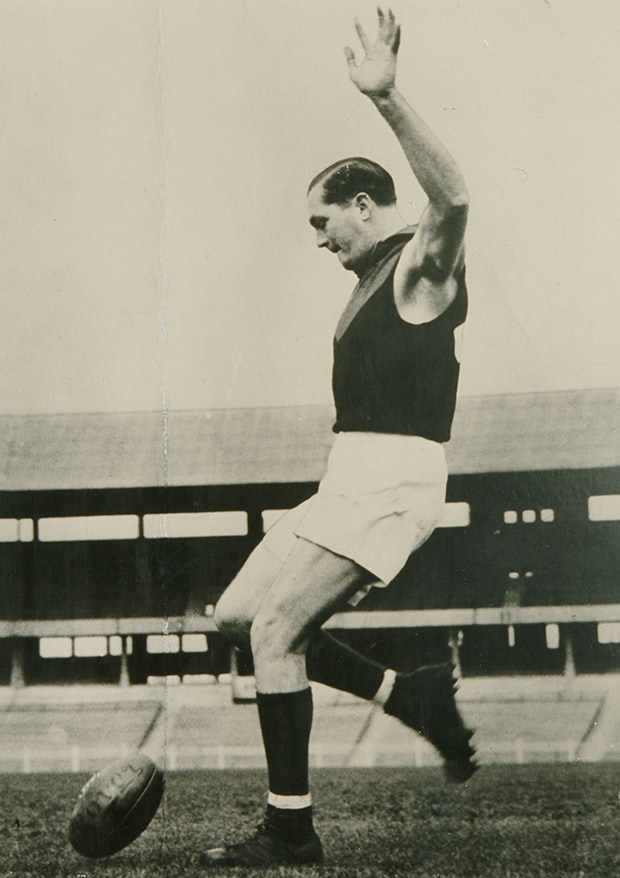
Jack Mueller pictured in the 1930s
1935
The club has 12 debutants, including the legendary Norm Smith, as Melbourne finishes sixth for the second year in a row. It claims eight wins and one draw. Allan La Fontaine wins Melbourne’s first club best and fairest award, while Maurie Gibb boots 59 majors to lead the club’s goalkicking. Joe Kinnear claims the Gardiner Medal in the reserves. Incredibly, Melbourne wins its fifth successive premiership in the seconds.
1936
Melbourne returns to the finals for the first time since 1928, defeating Carlton in the first semi-final by nine points at the MCG, before going down to South Melbourne by 36 points at the ‘G in the preliminary final. Allan La Fontaine becomes captain, and goes back-to-back in Melbourne’s best and fairest award, while Eric Glass lands 56 goals to head the club’s goal scoring Going for its sixth consecutive flag in the seconds, Melbourne is defeated by South Melbourne.
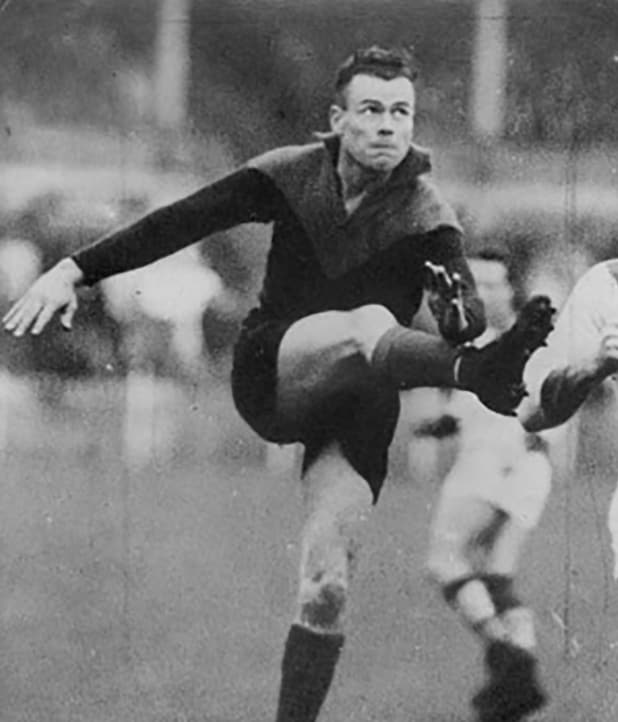
Ron Barassi Senior debuted for the club in 1936
1937
Melbourne starts with eight consecutive wins, then its best start to a season, before finishing second after the home and away season, and third at the end of the year. The club goes out in straight sets after falling to Geelong in the second semi-final by 12 points at the MCG, and then losing comfortably to Collingwood in the preliminary final by 55 points at the Cricket Ground. Ron Baggott kicks 51 goals to top the club’s goals and J.W. Saunders becomes chairman of a new Melbourne coterie group – the first of its kind in the VFL.
1938
Melbourne misses out on the top four when it falls to Collingwood by nine points at Victoria Park in the final round. It finishes fifth with 11 wins. Norm Smith wins Melbourne’s best and fairest award and kicks 80 goals to lead the club’s goalkicking – then a club record.

